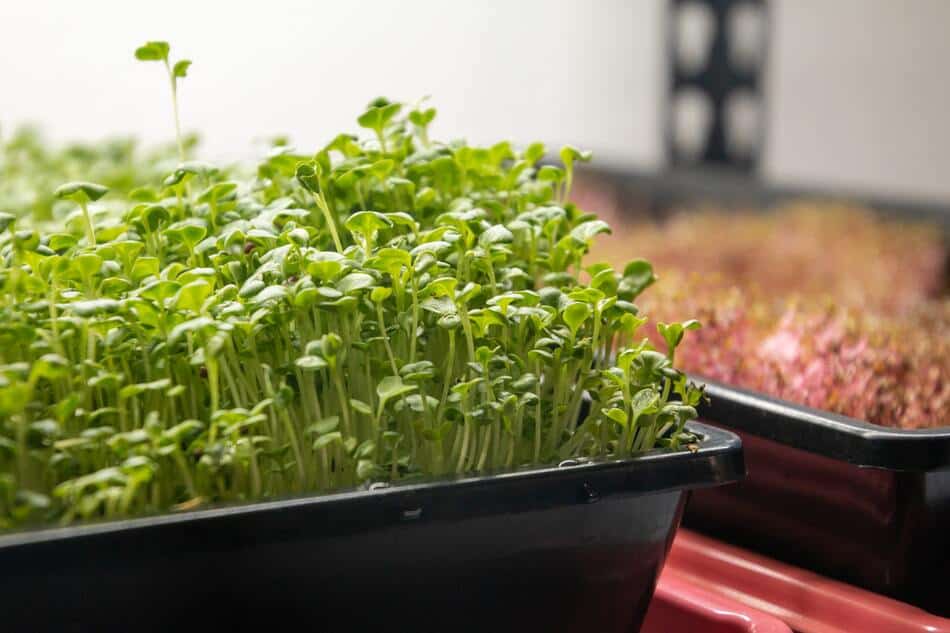Are you thinking of how to deal with mold when growing microgreens? Mold can be a big issue when it comes to growing microgreens. If not dealt with, it can ruin an entire crop and cause you to lose money. In this article, I will discuss how to deal with mold when growing microgreens. I will offer some tips on how to prevent it from happening in the first place. Stay tuned for more information!
If you are growing microgreens and notice mold, the first thing to do is remove any affected plants. If the mold is extensive, you may need to throw away all of your plants and start over. It is important to take action quickly as mold can spread rapidly in moist conditions.
What Causes Molds To Grow On Microgreens
Molds can grow on microgreens for a variety of reasons, including too much moisture, not enough light, and improper ventilation. Here are five common causes of mold growth on microgreens:
Too Much Moisture
Microgreens need to be kept moist to grow, but too much moisture can lead to mold growth. Make sure you’re using a well-draining soil mix and watering your microgreens just enough to keep the soil moist without making it soggy.

Not Enough Light
Microgreens need plenty of bright light to grow healthy and strong. If they’re not getting enough light, they may start to stretch and become leggy, which can make them more susceptible to mold growth.
Improper Ventilation
Good air circulation is important for preventing mold growth on microgreens. If your growing area is too cramped or doesn’t have enough ventilation, molds can quickly take over.
Too Much Heat
While microgreens need some warmth to grow, too much heat can also lead to mold problems. If your growing area is too hot and humid, try moving it to a cooler location or increasing the ventilation.
pH Balance Issues
The pH level of your soil can also affect mold growth on microgreens. Most microgreens prefer slightly acidic soils with a pH between six and seven. If your soil is too alkaline, it can make it more difficult for microgreens to take up nutrients and make them more susceptible to mold. You can test the pH level of your soil with a simple soil test kit.
Many different types of mold can affect microgreens, but the most common is powdery mildew. Powdery mildew is a fungus that affects a wide range of plants, including vegetables, fruits, and ornamentals. It is characterized by white or grayish-white patches on the leaves and stems of affected plants. Powdery mildew can weaken plants and make them more susceptible to other diseases.

By understanding the common causes of mold growth on microgreens, you can take steps to prevent it from happening in your growing operation. Keep an eye on moisture levels, provide plenty of light and ventilation, and maintain a healthy pH balance in your soil to help keep molds at bay.
How To Deal With Mold When Growing Microgreens
If you’re growing microgreens indoors, there’s a good chance you’ll run into the mold at some point. While it may seem like a daunting task to get rid of, there are a few simple steps you can take to rid your grow space of mold for good.
Here are five tips for dealing with mold when growing microgreens:
- Remove any affected plants immediately – As soon as you notice mold on any of your plants, remove them from the grow space. This will help prevent the spread of mold to other plants.
- Increase air circulation – One way to discourage mold growth is by increasing air circulation in your grow space. This can be done by opening up windows or using fans.
- Keep things clean – Mold can oftentimes grow in dirty environments. Be sure to clean your grow space regularly, paying special attention to areas where mold is likely to form (such as under the sink or in corners).
- Use an air purifier – An air purifier can help remove mold spores from the air, making it less likely for them to land on your plants and cause mold growth.
- Monitor humidity levels – High humidity levels are one of the main conditions that lead to mold growth. Monitor the humidity in your grow space and take steps to lower it if necessary. This can be done by using a dehumidifier or simply opening up windows on days when the humidity is high.
By following these tips, you can keep mold from taking over your microgreen grow space. With a little bit of effort, you can maintain a healthy and mold-free environment for your plants.
Can I Use Vinegar Or Bleach To Remove Molds On Microgreens?
There are a few ways to remove molds from your microgreens. You can use vinegar, bleach, or a combination of both. Vinegar is an acidic solution that can kill most types of mold. Bleach is a strong disinfectant that will also kill mold spores. To use either of these solutions, mix one-part vinegar or bleach with four parts water. Then, soak a paper towel in the solution and use it to wipe down the affected areas.
If you’re worried about using chemicals on your microgreens, you can also try a natural solution like baking soda. Baking soda is a mild abrasive that can help to scrub mold spores away from surfaces. To use this method, mix one-part baking soda with four parts water. Then, soak a paper towel in the solution and use it to scrub the affected areas.
Once you’ve removed the mold from your microgreens, be sure to wash them thoroughly with clean water. This will help to remove any residual mold spores or chemicals that could potentially make you sick. Mold can grow quickly in humid or wet conditions, so it’s important to keep your growing area clean and dry. If you see mold starting to form, take action right away to remove it before it has a chance to spread.
Final Words
Mold is a common problem when growing microgreens, but it doesn’t have to be a deal-breaker. By taking some simple precautions and being quick to act when you see mold, you can keep your plants healthy and happy. Thanks for reading, and good luck with your gardening!
Do you have any tips for dealing with mold when growing microgreens? Share them in the comments below!
Related Articles

